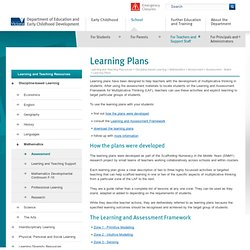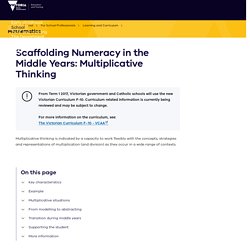

Learning Plans. Learning plans have been designed to help teachers with the development of multiplicative thinking in students.

After using the assessment materials to locate students on the Learning and Assessment Framework for Multiplicative Thinking (LAF), teachers can use these activities and explicit teaching to target particular groups of students. To use the learning plans with your students: How the plans were developed The learning plans were developed as part of the Scaffolding Numeracy in the Middle Years (SNMY) research project by small teams of teachers working collaboratively across schools and within clusters.
Each learning plan gives a clear description of two to three highly focussed activities or targeted teaching that can help scaffold learning in one or two of the specific aspects of multiplicative thinking from a particular zone of the LAF to the next. They are a guide rather than a complete list of lessons at any one zone. The Learning and Assessment Framework More information. Authentic Tasks. The main point of an authentic task is to encourage students to find ways of solving rich mathematical tasks themselves.

Different ways of solving a task reveal qualitatively different knowledge and skill sets, and these can be evaluated in terms of the Learning and Assessment Framework for Multiplicative Thinking (LAF). To use the authentic tasks with your students: How the authentic tasks were developed Authentic tasks in the Scaffolding Numeracy in the Middle Years (SNMY) project were developed at a school level by teachers and students. Teachers and students researched possible problems, community issues or tasks that needed to be addressed and chose one of these to develop as an authentic task. How to define an authentic task In general, an authentic task is one which: Purposeful and engaging Students, teachers and the community should see some real value in working on the task – that is, they want to solve it and see that it is worth the time spent on it.
Puts knowledge to work.
The Zones. The Eight Zones. Development of the LAF The Learning and Assessment Framework for Multiplicative Thinking (LAF) was developed on the basis of a detailed item analyses (Rasch Modelling) on data collected from approximately 3000 student responses to multiplicative assessment tasks administered at the beginning and end of the Scaffolding Numeracy in the Middle Years (SNMY) project.

The analysis dealt with predicting the probability of correct responses to test items as a function of student’s ability. The Learning and Assessment Framework for Multiplicative Thinking. Scaffolding Numeracy in the Middle Years. Multiplicative Thinking. From Term 1 2017, Victorian government and Catholic schools will use the new Victorian Curriculum F-10.

Curriculum related information is currently being reviewed and may be subject to change. For more information on the curriculum, see:The Victorian Curriculum F–10 - VCAA Page Content Multiplicative thinking is indicated by a capacity to work flexibly with the concepts, strategies and representations of multiplication (and division) as they occur in a wide range of contexts. Multiplicative thinking is characterised by: a capacity to work flexibly and efficiently with an extended range of numbers (for example, larger whole numbers, decimals, common fractions, ratio and percent)an ability to recognise and solve a range of problems involving multiplication or division including direct and indirect proportionthe means to communicate this effectively in a variety of ways (for example, words, diagrams, symbolic expressions and written algorithms). to problems such as: What do they mean?